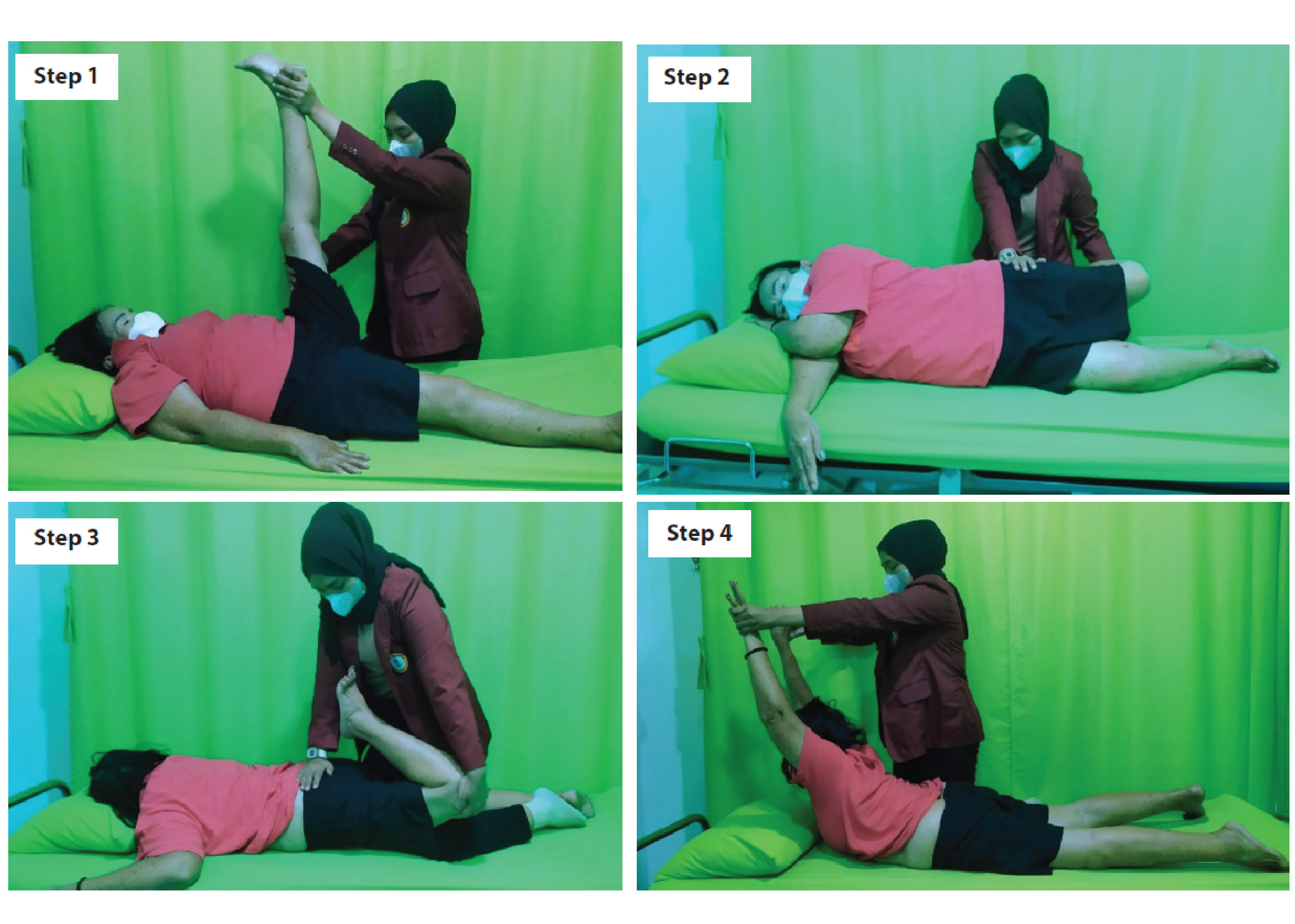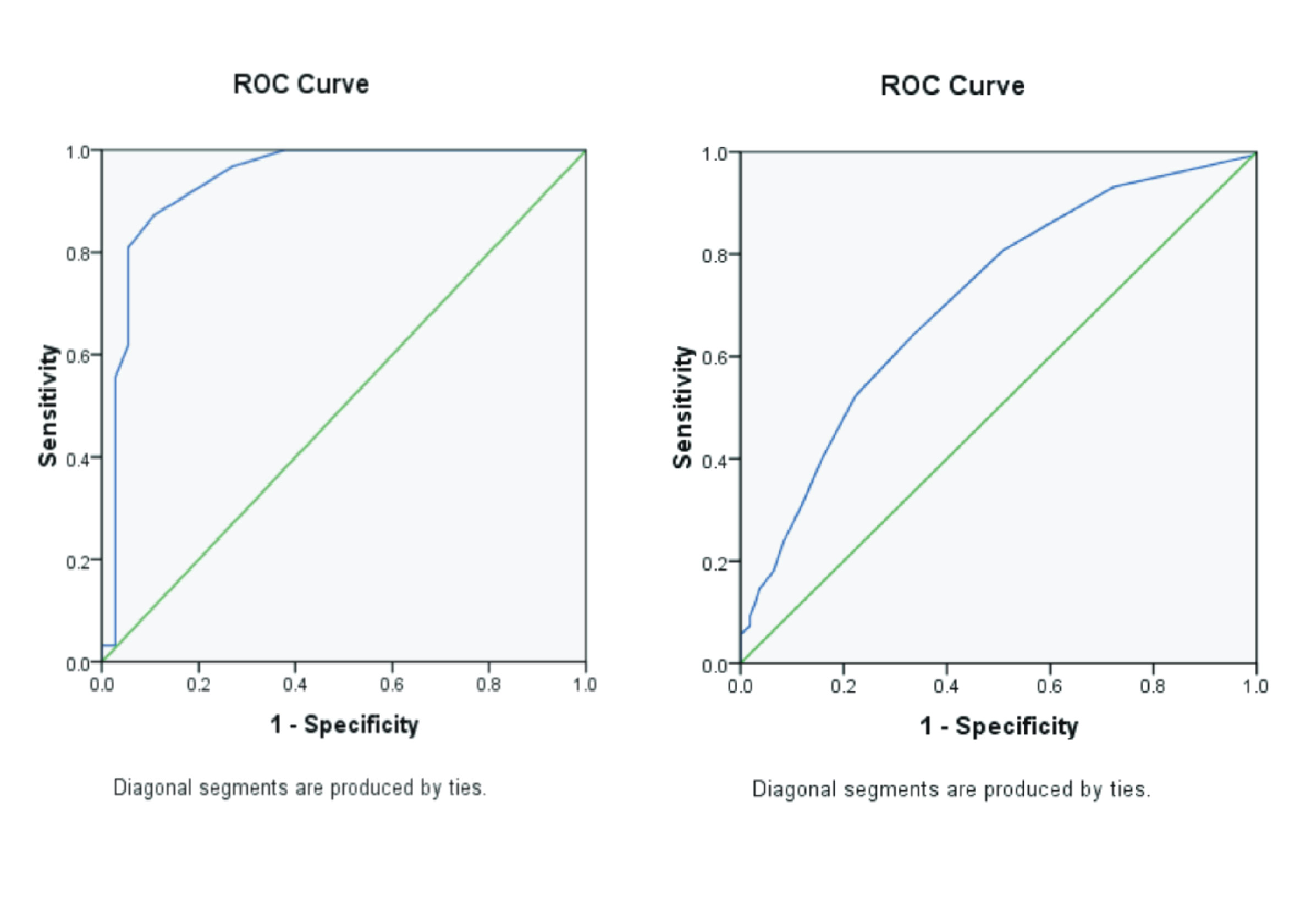A COMPARATIVE STUDY OF PHYSIOTHERAPY OUTCOMES BETWEEN INFRARED-TENS COMBINATION AND PNF THERAPIES IN NPH PATIENTS

Background: The pain experienced by Nucleus Pulposus Herniation (NPH) patients can have an impact on productivity and may lead to disability. Therefore, non-pharmacological therapies can serve as alternatives in reducing pain levels for Grade I and Grade II NPH patients. Purpose: To compare the difference in effectiveness between Infrared-Transcutaneous Electrical Nerve Stimulation (IR-TENS) combination and Proprioceptive Neuromuscular Facilitation (PNF) therapies in reducing pain among NPH patients. Method: This research employed a quasi-experimental design with a two group before and after intervention conducted at the Physical Medicine and Rehabilitation Unit of Royal Prima Hospital in Medan. A total of 20 NPH patients were provided with interventions, consisting of a combination of IR and TENS therapies for 10 patients, and PNF therapy for the other 10 patients, administered eight times for one month. Pain measurement was conducted using a Visual Analogue Scale (VAS) questionnaire before and after the interventions. The statistical analysis employed an Independent Sample T test, with a significance level (α) set at 0.05. Result: There was a reduction in moderate and severe pain scales in both groups, and no subjects were experiencing severe pain anymore. However, the reduction in moderate pain scale was higher in the group receiving the combination of infrared and TENS therapies (80%) compared to the PNF therapy (70%). The Independent T test showed that there was no significant difference between the effectiveness of the combination of IR-TENS therapies and PNF therapy on pain in NPH patients (p-value = 0.075). Conclusion: Both groups of patients experienced a reduction in pain scale after the interventions, although there was no significant difference in the outcome between the two treatment groups. This implies that both therapies are equally effective in suppressing pain in NPH patients.
Introduction
Low Back Pain(LBP) is a common musculoskeletal issue that occurs worldwide and is estimated to be one of the most prevalent complaints experienced by 80% of the global population (Uritset al., 2019(Urits et al., 2019)). The Basic Health Research of 2018 reported the prevalence of musculoskeletal diseases in Indonesia to be 7.3% (Agency for Health Research and Development, 2020(Source Title, 2018)). One of the diseases frequently encountered in lower back pain isNucleus Pulposus Herniation(NPH), characterized by clinical symptoms such as lower back pain radiating to the lower extremities or even extending to the toes. If the condition worsens, it can lead to paralysis (Dydyk et al., 2024(Dydyk et al., 2024); Schroeder et al., 2016(Schroeder et al., 2016)). NPH is a medical condition where the cushion or intervertebral disc protrudes and compresses the spinal nerve fibers, causing lower back pain that predominantly occurs between the L4 and L5 vertebrae. Part or the entire nucleus pulposus protrudes toward the spinal canal (De Decker and Fenn, 2018(Decker & Fenn, 2018)).
Several literature sources identify risk factors for NPH, including older age, smoking habits,Body Mass Index(BMI), and occupation (workload, working positions, repetition, and duration) (Sørensen et al., 2011(Sørensen et al., 2011); Ahsan et al., 2013(Ahsan et al., 2013); Billy et al., 2014(Billy et al., 2014); Citko et al., 2018(Citko et al., 2018); Lan et al., 2016(Lan et al., 2016); Li et al., 2020(Li et al., 2020); Nordberg et al., 2021(Nordberg et al., 2021); Siccoli et al., 2022(Siccoli et al., 2022)). Previous literature reports that the treatment of NPH with severe pain intensity can be managed through interventions such as nerve root steroid injections or even surgery. However, many NPH patients can reduce their pain through conservative treatments such as analgesics, epidural injections, and physical therapies like traction, ultrasound, and low-level laser therapy (Alentado et al., 2014(Alentado et al., 2014); Altun and Yüksel, 2017(Altun & Yüksel, 2017); Benoist, 2002(Benoist, 2002); Suri et al., 2012(Suri et al., 2012); Unlu et al., 2008(Unlu et al., 2008)). Indeed, non-pharmacological therapies can also be employed to reduce pain in NPH patients, such asTranscutaneous Electrical Nerve Stimulation(TENS), ultrasound, infrared (IR) therapy, interferential therapy, short-wave diathermy, lumbar traction, McKenzie exercises, core stability exercises, andProprioceptive Neuromuscular Facilitation(PNF) (Chou et al., 2016(Chou et al., 2016); Barreto and Lin, 2017(Barreto & Lin, 2017); Gao et al., 2022(Gao et al., 2022)). In this research, the researchers selected three types of physiotherapy modalities to be applied to NPH patients, namely a combination of IR and TENS therapies, as well as PNF therapy.
Infrared(IR) therapy is a physical therapy modality that involves electromagnetic radiation with light rays that produce a heating effect when absorbed by the skin. The heat emitted by infrared has been shown to enhance tissue extensibility, aid in improving joint range of motion, reduce pain sensation, and promote the healing of soft tissue lesions (Anekwu, 2015(Anekwu, 2015); Ojeniweh et al., 2019(Ojeniweh et al., 2019)). TENS is an electrical stimulation method used to stimulate the posterior horn nerve cells and produce a sedative effect (American Physical Therapy Association, 2000(Source Title, 2000)). This method has been proven effective in reducing pain, alleviating clinical symptoms, and regulating peripheral oxygen radical levels. Additionally, it helps prevent oxidative damage to cardiac muscle tissue (Unterrainer et al., 2010(Unterrainer et al., 2010); Wang et al., 2018(Wang et al., 2018)). In addition to being cost-effective and easy to learn, TENS has a low risk of hazards, including toxicity or other side effects (Gladwell et al., 2015(Gladwell et al., 2015); Jauregui et al., 2016(Jauregui et al., 2016); Teoli and An, 2023(Teoli & An, 2024)). The PNF therapy is utilized to elicit neuromuscular responses by facilitating proprioceptors. PNF can stimulate proprioceptors in muscles and joints around the waist region, which may be beneficial in enhancing sensorimotor regulation and balance performance. This therapy has been shown to be quite effective in reducing pain (Kofotolis and Kellis, 2006(Kofotolis & Kellis, 2006); Westwater-Wood et al., 2010(Westwater-Wood et al., 2010); Young et al., 2015(Young et al., 2015); Areeudomwong et al., 2017(Areeudomwong et al., 2017)).
Based on the preliminary survey conducted at the Medical Record Installation of Royal Prima Hospital in Medan, the number of visits by NPH patients with complaints of lower back pain was recorded to be 50 patients per month from January to December 2022. The objective of this research was to compare the effectiveness of a combination of IR and TENS therapies, as well as PNF therapy in reducing pain among NPH patients.
Material and Method
This research has obtained ethical approval from the Research Ethics Committee of Universitas Prima Indonesia with registration number: 070/KEPK/UNPRI/VII/2023. This research employed a quasi-experimental design with a two group before and after intervention. The research was conducted at the Medical Rehabilitation Installation (Physiotherapy) of Royal Prima Hospital in Medan from January to May 2023. The average number ofNucleus Pulposus Herniation(NPH) patients accessing physiotherapy services ranged from 8 to 10 individuals per day, totaling approximately 160 patients in a
Abid, M., Ullah Khan, H., Huzea Abid, M., Ijaz, A., Ahmad, M., Tayyab Naeem, M., Raza, H., 2021. Association of Occupational Risk Factors with the Level of Lumbar Disc Nucleus Pulposus Herniation. Pakistan Journal of Medical and Health Sciences Vol. 15(10), Pp. 2863–2864.
Agency for Health Research and Development, 2018. Laporan Nasional Riskesdas 2018. Lembaga Penerbit Badan Penelitian dan Pengembangan Kesehatan, Jakarta.
Ahsan, M.K., Matin, T., Ali, M.I., Ali, M.Y., Awwal, M.A., Sakeb, N., 2013. Relationship between Physical Work Load and Lumbar Disc Herniation. Mymensingh Medical Journal: MMJ Vol. 22(3), Pp. 533-540.
Alentado, V.J., Lubelski, D., Steinmetz, M.P., Benzel, E.C., Mroz, T.E., 2014. Optimal Duration of Conservative Management Prior to Surgery for Cervical and Lumbar Radiculopathy: A Literature Review. Global Spine Journal Vol. 4(4), Pp. 279-286.
Altun, I., Yüksel, K.Z., 2017. Lumbar Herniated Disc: Spontaneous Regression. The Korean Journal of Pain Vol. 30(1), Pp. 44-50.
American Physical Therapy Association, 2000. Electrotherapeutic Terminology in Physical Therapy. American Physical Therapy Association.
Anekwu, E., 2015. Efficacy of Six Weeks Infrared Radiation Therapy on Chronic Low back Pain and Functional Disability in National Orthopaedic Hospital, Enugu, South East, Nigeria. The Nigerian Health Journal Vol. 15(4), Pp.155–160.
Ansari, N.N., Naghdi, S., Naseri, N., Entezary, E., Irani, S., Jalaie, S., Hasson, S., 2014. Effect of Therapeutic Infra-Red in Patients with Non-Specific Low Back Pain: A Pilot Study. Journal of Bodywork and Movement Therapies Vol. 18(1), Pp. 75-81.
Areeudomwong, P., Wongrat, W., Neammesri, N., Thongsakul, T., 2017a. A Randomized Controlled Trial on The Long-Term Effects of Proprioceptive Neuromuscular Facilitation Training, on Pain-Related Outcomes and Back Muscle Activity, in Patients with Chronic Low Back Pain. Musculoskeletal Care Vol. 15(3), Pp. 218-229.
Barolla, I., Paliyama, M., Huwae, L., 2021. Perbandingan Efek Terapi Transcutaneus Electrical Nerve Stimulation dan Infra Red dengan Infra Red dalam Pengurangan Nyeri pada Penderita Ischialgia di RSUD dr. M. Haulussy Ambon. PAMERI: Pattimura Medical Review Vol. 3, Pp. 1-7.
Barreto, T., Lin, K., 2017. Noninvasive Treatments for Low Back Pain. American Family Physician.
Benoist, M., 2002. The Natural History of Lumbar Disc Herniation and Radiculopathy. Joint Bone Spine Vol. 69(2), Pp. 155-160.
Billy, G.G., Lemieux, S.K., Chow, M.X., 2014. Changes in Lumbar Disk Morphology Associated with Prolonged Sitting Assessed by Magnetic Resonance Imaging. PM R Vol. 6(9), Pp. 790-795.
Budiono, A., 2016. Pengaruh Latihan Proprioceptive Neuromuscular Facilitation (PNF) Pasca Cedera Bahu terhadap Perbaikan Range of Motion (ROM). Universitas Negeri Yogyakarta.
Chou, R., Deyo, R., Friedly, J., Skelly, A., Hashimoto, R., Weimer, M., Fu, R., Dana, T., Kraegel, P., Griffin, J., Grusing, S., Brodt, E., 2016. Noninvasive Treatments for Low Back Pain, AHRQ Comparative Effectiveness Reviews. Agency for Healthcare Research and Quality (US), Rockville (MD).
Cicco, F.L. De, Willhuber, G.O.C., 2022. Nucleus Pulposus Herniation. StatPearls Publishing, Treasure Island (FL).
Citko, A., Górski, S., Marcinowicz, L., Górska, A., 2018. Sedentary Lifestyle and Nonspecific Low Back Pain in Medical Personnel in North-East Poland. BioMed Research International Pp. 965807.
De Decker, S., Fenn, J., 2018. Acute Herniation of Nondegenerate Nucleus Pulposus. The Veterinary Clinics of North America: Small Animal Practice Vol. 48(1), Pp. 95–109.
Dwi, W., M, M., Fauziah, E., 2020. Penatalaksanaan Fisioterapi untuk Gangguan Fungsional Lumbal pada Kasus Hernia Nukleus Pulposus dengan Teknik PNF, Tens, dan Mckenzie Exercise di RSUD Ulin Banjarmasin Tahun 2019. Jurnal Kajian Ilmiah Kesehatan dan Teknologi Vol. 2(1), Pp. 6-14.
Dydyk, A.M., Ngnitewe Massa, R., Mesfin, F.B., 2024. Disc Herniation. StatPearls Publishing, Treasure Island (FL).
Gale, G.D., Rothbart, P.J., Li, Y., 2006. Infrared Therapy for Chronic Low Back Pain: A Randomized, Controlled Trial. Pain Research & Management Vol. 11(3), Pp.193-196.
Gao, P., Tang, F., Liu, W., Mo, Y., 2022. The Effects of Proprioceptive Neuromuscular Facilitation in Treating Chronic Low Back Pain: A Systematic Review and Meta-Analysis. Journal of Back and Musculoskeletal RehabilitationVol. 35(1), Pp. 21-33.
Ginting, F.P., Susilo, T., 2022. Penatalaksanaan Fisioterapi pada Hernia Nukleus Pulposus Lumbal dengan Modalitas Infra Red, TENS dan MC Kenzie Exercise. Jurnal Gentle Birth Vol. 5(1), Pp. 74–80.
Gladwell, P.W., Badlan, K., Cramp, F., Palmer, S., 2015. Direct and Indirect Benefits Reported by Users of Transcutaneous Electrical Nerve Stimulation for Chronic Musculoskeletal Pain: Qualitative Exploration Using Patient Interviews. Physical Therapy Vol. 95(11), Pp. 1518-1528.
Gordon, R., Bloxham, S., 2016. A Systematic Review of the Effects of Exercise and Physical Activity on Non-Specific Chronic Low Back Pain. Healthcare (Basel) Vol. 4(2), Pp. 22.
Hasesa, F., 2022. Penatalaksanaa Hernia Nucleus Pulposus dengan Infra Red, Transcutaneous Electrical Nerve Stimulation, dan McKenzie Exercise (Skripsi). Universitas Widya Husada Semarang.
Hindle, K.B., Whitcomb, T.J., Briggs, W.O., Hong, J., 2012. Proprioceptive Neuromuscular Facilitation (PNF): Its Mechanisms and Effects on Range of Motion and Muscular Function. Journal of Human Kinetics Vol. 31, Pp. 105-113.
Ikhsanawati, A., Tiksnadi, B., Soenggono, A., Hidajat, N.N., 2015. Herniated Nucleus Pulposus in Dr. Hasan Sadikin General Hospital Bandung Indonesia. Althea Medical Journal Vol. 2(2), Pp. 179–185.
Iqbal, M.N., Akhter, S., Irfan, M., 2015. Prevalence of Hernia in Relation to Various Risk Factors in District Narowal, Pakistan. Science Letters Vol. 3(1), Pp. 29–32.
Jauregui, J.J., Cherian, J.J., Gwam, C.U., Chughtai, M., Mistry, J.B., Elmallah, R.K., Harwin, S.F., Bhave, A., Mont, M.A., 2016. A Meta-Analysis of Transcutaneous Electrical Nerve Stimulation for Chronic Low Back Pain. Surgical Technology International Vol. 28, Pp. 296-302.
Kofotolis, N., Kellis, E., 2006. Effects of Two 4-Week Proprioceptive Neuromuscular Facilitation Programs on Muscle Endurance, Flexibility, and Functional Performance in Women with Chronic Low Back Pain. Physical Therapy Vol. 86(7), Pp. 1001-1012.
Lan, F.-Y., Liou, Y.-W., Huang, K.-Y., Guo, H.-R., Wang, J.-D., 2016. An Investigation of A Cluster of Cervical Herniated Discs among Container Truck Drivers with Occupational Exposure to Whole‐Body Vibration. Journal of Occupational Health Vol. 58(1), Pp. 118-127.
Li, Y., Shi, J.-J., Ren, J., Guan, H.-S., Gao, Y.-P., Zhao, F., Sun, J., 2020. Relationship Between Obesity and Lumbar Disc Herniation in Adolescents. Zhongguo Gu Shang Vol. 33(8), Pp. 725-729.
Nordberg, C.L., Boesen, M., Fournier, G.L., Bliddal, H., Hansen, P., Hansen, B.B., 2021. Positional Changes in Lumbar Disc Herniation During Standing or Lumbar Extension: A Cross-Sectional Weight-Bearing MRI Study. European Radiology Vol. 31(2), Pp. 804-812.
Ojeniweh, O.N., Ezema, C.I., Okoye, G.C., 2019. Efficacy of Infrared Radiation Therapy on Chronic Low Back Pain: A Case Study of National Orthopaedic Hospital, Enugu, South East, Nigeria. International Journal of Basic, Applied and Innovative Research Vol. 7, Pp.107–114.
Pop, T., Austrup, H., Preuss, R., Niedziałek, M., Zaniewska, A., Sobolewski, M., Dobrowolski, T., Zwolińska, J., 2010. Effect of TENS on Pain Relief in Patients with Degenerative Disc Disease in Lumbosacral Spine. Ortopedia, Traumatologia, Rehabilitacja Vol. 12(4), Pp. 289-300.
Schroeder, G.D., Guyre, C.A., Vaccaro, A.R., 2016. The Epidemiology and Pathophysiology of Lumbar Disc Herniations. Seminars in Spine Surgery, Lumbar Disc Herniation Vol. 28(1), Pp. 2-7.
Siccoli, A., Staartjes, V.E., Klukowska, A.M., Muizelaar, J.P., Schröder, M.L., 2022. Overweight and Smoking Promote Recurrent Lumbar Disk Herniation after Discectomy. European Spine Journal Vol. 31(3), Pp. 4-613.
Sørensen, I., Jacobsen, P., Gyntelberg, F., Suadicani, P., 2011. Occupational and Other Predictors of Herniated Lumbar Disc Disease—A 33-Year Follow-up in The Copenhagen Male Study. Spine Vol. 36(19), Pp. 1541-6.
Suri, P., Rainville, J., Gellhorn, A., 2012. Predictors of Patient-Reported Recovery from Motor or Sensory Deficits Two Years after Acute Symptomatic Lumbar Disk Herniation. PM & R: The Journal of Injury, Function, and Rehabilitation Vol. 4(12), Pp. 936-944.
Tanderi, E.A., Kusuma, T.A., Hendrianingtyas, M., 2017. Hubungan Kemampuan Fungsional dan derajat Nyeri pada Pasien Low Back Pain Mekanik di Instalasi Rehabilitasi Medik RSUP dr. Kariadi Semarang. Jurnal Kedokteran Diponegoro Vol. 6(1).
Teoli, D., An, J., 2024. Transcutaneous Electrical Nerve Stimulation. In: StatPearls. StatPearls Publishing, Treasure Island (FL).
Unlu, Z., Tasci, S., Tarhan, S., Pabuscu, Y., Islak, S., 2008. Comparison of 3 Physical Therapy Modalities For Acute Pain in Lumbar Disc Herniation Measured by Clinical Evaluation and Magnetic Resonance Imaging. Journal of Manipulative and Physiological Therapeutics Vol. 31(3), Pp. 191-198.
Unterrainer, A.F., Friedrich, C., Krenn, M.H., Piotrowski, W.P., Golaszewski, S.M., Hitzl, W., 2010. Postoperative and Preincisional Electrical Nerve Stimulation TENS Reduce Postoperative Opioid Requirement After Major Spinal Surgery. Journal of Neurosurgical Anesthesiology Vol. 22(1), Pp. 1–5.
Urits, I., Burshtein, A., Sharma, M., Testa, L., Gold, P.A., Orhurhu, V., Viswanath, O., Jones, M.R., Sidransky, M.A., Spektor, B., Kaye, A.D., 2019. Low Back Pain, a Comprehensive Review: Pathophysiology, Diagnosis, and Treatment. Current Pain and Headache Reports Vol. 23(3), Pp. 23.
Wang, L., Fan, W., Yu, C., Lang, M., Sun, G., 2018. Clinical Effects of Electrical Stimulation Therapy on Lumbar Disc Herniation-Induced Sciatica and Its Influence on Peripheral ROS level. Journal of Musculoskeletal & Neuronal Interactions Vol. 18(3), Pp. 393-398.
Westwater-Wood, S., Adams, N., Kerry, R., 2010. The Use of Proprioceptive Neuromuscular Facilitation in Physiotherapy Practice. Physical Therapy Reviews Vol. 15(1), Pp. 23–28.
Young, K.J., Je, C.W., Hwa, S.T., 2015. Effect of Proprioceptive Neuromuscular Facilitation Integration Pattern and Swiss Ball Training on Pain and Balance in Elderly Patients with Chronic Back Pain. Journal of Physical Therapy Science Vol. 27(10), Pp. 3237-3240.
Copyright (c) 2025 Journal of Vocational Health Studies

This work is licensed under a Creative Commons Attribution-NonCommercial-ShareAlike 4.0 International License.
- The authors agree to transfer the transfer copyright of the article to the Journal of Vocational Health Studies (JVHS) effective if and when the paper is accepted for publication.
- Legal formal aspect of journal publication accessibility refers to Creative Commons Attribution-NonCommercial-ShareAlike (CC BY-NC-SA), implies that publication can be used for non-commercial purposes in its original form.
- Every publications (printed/electronic) are open access for educational purposes, research, and library. Other that the aims mentioned above, editorial board is not responsible for copyright violation.
Journal of Vocational Health Studies is licensed under a Creative Commons Attribution-NonCommercial-ShareAlike 4.0 International License














































